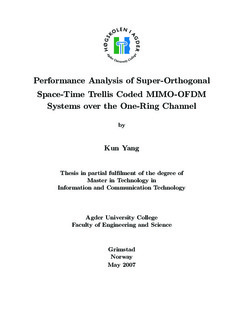| dc.description.abstract | With the rapid development of wireless communications, the available bandwidth for wireless
applications becomes more and more insufficient. Therefore, how to improve data
rate without expending bandwidth becomes a main goal in modern communication system
design. Recently, two wireless communication schemes, which can be used to effectively
combat with multi-path fading, are widely investigated around the world. One is
the multiple-input multiple-output (MIMO) technology and another is the orthogonal frequency
division multiplexing (OFDM). As a result, a combined system, MIMO-OFDM,
can be used for wireless communications to jointly explore the advantages of the above two
strategies.
In the study of MIMO-OFDM systems, the space-time block codes (STBC) and the spacetime
trellis codes (STTC) are two efficient coding approaches. The former can be used to
offer a full diversity gain, and the later can provide the systems with a large coding gain.
Since 2003, super-orthogonal space-time trellis codes (SOSTTC), a new coding method
processing the merits of both STBC and STTC, have been developed. However, whether
or not it can perform just as well in a MIMO-OFDM system over a frequency-selective
channel is still unknown. In addition, a communication channel plays a very important
role on a communication system. A channel model is used to describe a realistic communication
channel and its various model parameters are considered to influence the system
performance such as symbol error rate (SER) as well as bit error rate (BER). Therefore,
the effects on SER and BER, caused by changing channel parameters, are worth to be
investigated.
In the thesis, a new SOSTTC scheme for 16QAM constellation which can be used for
high speed wireless communications is applied to a MIMO-OFDM system. To examine
the performance of the proposed MIMO-OFDM system based on SOSTTC, the one-ring
MIMO channel model is studied by evaluating the effects of antenna spacing, channel profiles
and maximum Doppler frequency shift.
In MATLAB simulations, the SER and the BER performance results show that enlargement
of the antenna spacing can bring a higher diversity gain, and the enlargement of
the antenna spacing at base station can achieve better system performance than at the
mobile station. In the channel profiles, the model E can gain more 1.5dB on the SER than
the other models at a SER of 10−2. In addition, the larger maximum Doppler frequency
shift can cause more data errors by assuming non-perfect channel state information (CSI).
Finally, by using SOSTTC, the system performance on SER can be improved by 0.5 to
1dB at a SER of 5×10−4, comparing it with the STBC in the same MIMO-OFDM system.
According to the above results, it will be more efficient to increase antenna spacing at the base station and it is necessary to adjust the coding scheme and signal power to avoid
performance decrease in a different communication environment and at a different speed
of the mobile unite. Moreover, the SOSTTC can be integrated with MIMO-OFDM system
to increase system performance.
Keywords: MIMO-OFDM, SOSTTC, 16QAM, One-ringMIMO channel model, SER, BER. | en |
